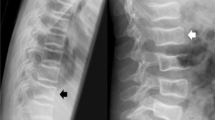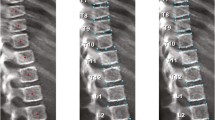Abstract
To compare visual semiquantitative (SQ) reading and quantitative morphometry (QM) for assessing prevalent and incident vertebral fractures, radiographs of the thoracolumbar spine were evaluated in 400 (only baseline films) and 335 (baseline and follow-up films) postmenopausal women with osteopenia as defined by aT-score of less than 2 SD below young normals. QM was performed using different cutoff thresholds, and the SQ reading was performed by three radiologists independently. A joint consensus reading of the radiographs by all participating radiologists was used as a reference standard. Our results indicate that the concordance within SQ methods is excellent, and it is higher than that between SQ and QM regardless of the cutoff criteria used. This finding was consistent for the diagnosis of prevalent as well as incident vertebral fractures. For prevalent fractures the use of the 2.5 SD cutoff criterion provided the highest concordance with the consensus reading and with the radiologists' reading, thereby providing high sensitivity (70.23%) with moderate specificity (98.76%) relative to the consensus reading when compared with the 3 SD or 4 SD cutoff criteria. For the diagnosis of incident vertebral fractures the best agreement between our consensus reading and QM was found for an absolute reduction of 6 mm and for a combination of relative and absolute reduction of 15% and 3 mm in vertebral height. The respective sensitivities and specificities for the two criteria were 51%/99.9% and 75.4%/98.9%, respectively. Even though the consensus reading may favor the reader's evaluation over QM, the assessment of prevalent and incident fractures using QM alone may not be sufficiently reliable for detection of vertebral fractures in epidemiological studies and clinical trials. It should be performed principally in conjunction with a trained radiologist or a highly experienced clinician.
Similar content being viewed by others
References
Kleerekoper M, Nelson DA, Peterson EL, Tilley BC. Outcome variables in osteoporosis trials. Bone 1992;13:S29–34.
Jensen GF, McNair P, Boesen J, Hegedüs V. Validity in diagnosing osteoporosis. Eur J Radiol 1984;4:1–3.
Nielsen VAH, Pødenphant J, Martens S, Gotfredsen A, Riis BJ. Precision in assessment of osteoporosis from spine radiographs. Eur Radiol 1991;13:11–4.
Hedlund LR, Gallagher JC. Vertebral morphometry in diagnosis of spinal fractures. Bone Miner 1988;5:59–67.
Smith-Bindman R, Cummings SR, Steiger P, Genant HK. A comparison of morphometric definitions of vertebral fracture. J Bone Miner Res 1991;6:25–34.
Kleerekoper M, Nelson DA. Vertebral fracture or vertebral deformity? Calcif Tissue Int 1992;50:5–6.
McCloskey EV, Spector TD, Khan S, et al. Prevalence of vertebral deformity and concordance between definitions of fracture. In: Christiansen C, Riis B, editors. Proceedings of Fourth International Symposium on Osteoporosis and Consensus Development Conference, Hong Kong. Copenhagen: Osteo-press, 1993:62–4.
Ryan PJ, Fogelman I. Osteoporotic vertebral fractures: diagnosis with radiography and bone scinitgraphy. Radiology 1994;190:669–72.
Orwoll E, Mann T, Oviatt S, Nelson D. Scheuermann's disease and vertebral deformity in men. J Bone Miner Res 1991;6 (Suppl 1):S223.
Genant HK, Wu CY, vanKuijk C, Nevitt M. Vertebral fracture assessment using a semi-quantitative technique. J Bone Miner Res 1993;8:1137–48.
Gallagher JC, Hedlund LR, Stoner S, Meeger C. Vertebral morphometry: normative data. Bone Miner 1988;4:189–96.
Kleerekoper M, Parfitt AM, Ellis BI. Measurement of vertebral fracture rates in osteoporosis. In: Christiansen C, Arnaud CD, Nordin BEC, et al., editors. Proceedings of Copenhagen International Symposium on Ostoporosis, 3–8 June 1984, Copenhagen. Glostrup: Department of Clinical Chemistry, Glostrup Hospital, 1984:103–8.
Minne HW, Leidig G, Wüster C, et al. A newly developed spine deformity index (SDI) to quantitate vertebral crush fractures in patients with osteoporosis. Bone Miner 1988;3:335–49.
Davies KM, Recker RR, Heaney RP. Revisable criteria for vertebral deformity. Osteoporosis Int 1993;3:265–70.
Davies KM, Recker RR, Heaney RP. Normal vertebral dimensions and normal variation in serial measurements of vertebrae. J Bone Miner Res 1989;4:341–9.
Eastell R, Cedel SL, Wahner HW, Riggs BL, Melton LJ III. Classification of vertebral fractures. J Bone Miner Res 1991;6:207–15.
Black DM, Cummings SR, Stone K, et al. A new approach to defining normal vertebral dimensions. J Bone Miner Res 1991;6:883–92.
Raymakers JA, Kapelle JW, van Berensteijn ECH, Duursma SA. Assessment of osteoporotic spine deformity: a new method. Skeletal RAdiol 1990;19:91–7.
McCloskey EV, Spector TD, Eyres KS, et al. The assessment of vertebral deformity: a method for use in population studies and clinical trials. Ostoeporosis Int 1993;3:138–47.
Ross PD, Yhee YK, He Y-F, et al. A new method for vertebral fracture diagnosis. J Bone Miner Res 1993;8:167–74.
Riggs BL, Hodgson SF, O'Fallon WM, et al. Effect of fluoride treatment in the fracture rate in postmenopausal women with osteoporosis. N Engl J Med 1990:322:802–9.
Storm T, Thamsborg G, Steiniche T, Genant HK, Sørenson OH. Effect of intermittent cyclical etidronate therapy on bone mass and fracture rate in women with postmenopausal osteoporosis. N Engl J Med 1990;322:1265–71.
Ross PD, Davis JW, Epstein RS, Wasnich RD. Pre-existing fractures and bone mass predict vertebral fracture incidence in women. Ann Intern Med 1991;114:919–23.
Ross PD, Davis JW, Epstein RS, Wasnich RD. Ability of vertebral dimensions from a single radiograph to identify fractures. Calcif Tissue Int 1992;51:95–9.
Nelson D, Peterson E, Tilley B, et al. Measurement of vertebral area on spine x-rays in osteoporosis: reliability of digitizing techniques. J Bone Miner Res 1990;5:707–16.
Landis JR, Koch GG. The measurement of observer agreement for categorical data. Biometrics 1977;33:159–74.
Leidig G, Storm T, Genant HK, et al. Comparison of two methods to assess vertebral fractures. In: Christiansen C, Over-gaard E, editors. Proceedings of Third International Symposium on Osteoporosis, Copenhagen. Copenhagen: Osteopress, 1990:626–8.
Sauer P, Leidig G, Minne HW, et al. Spine deformity index (SDI) versus other objective procedures of vertebral fracture identification in patients with osteoporosis. J Bone Miner Res 1991;6:227–38.
Adami S, Gatti D, Rossini M, et al. The radiological assessment of vertebral osteoporosis. Bone 1992;13 (Suppl):S33–6.
Leidig-Bruckner G, Genant HK, Minne HW, et al. Comparison of a semiquantitative and a quantitative method for assessing vertebral fracture in osteoporosis. Osteoporosis Int 1994;4:154–61.
Kanis JA, McCloskey EV, Khan S, Nakatsuka K, Sirtori P, What is a vertebral fracture? In: Christiansen C, Riis B, editors. Proceedings of Fourth International Symposium on Ostoeporosis and Consensus Development Conference, Hong Kong. Copenhagen: Osteopress, 1993:26–8.
Cummings SR, Melton LJ III, Felsenberg D, and National, Osteoporosis Foundation Working Group on Vertebral Fracture. Report: assessing vertebral fracture. J Bone Miner Res (in press).
Nicholson PHF, Haddaway MJ, Davie MWJ, Evans SF. Vertebral deformity, bone mineral density, back pain and height loss in unscreened women over 50 years. Osteoporosis Int 1993;3:300–7.
Ettinger B, Black DM, Nevitt MC, et al. Contributions of vertebral deformities to chronic back pain and disability. J Bone Miner Res 1992;7:449–56.
Ettinger B, Black DM, Palermo L, et al. Kyphosis in older women and its relation to back pain, disability and osteopenia: the study of osteoporotic fractures. Osteoporosis Int 1994;4:55–60.
Ryan PJ, Blake G, Herd R, Fogelman I. A clinical profile of back pain and disability in patients with spinal osteoporosis. Bone 1994;15:27–30.
Steiger P, Cummings SR, Genant HK, Weiss H, Morphometric X-ray absorptiometry of the spine: correlation in-vivo with morphometric radiography. In: Christiansen C, Riis B, editors. Proceedings of the Fourth International Symposium on Osteoporosis and Concensus Development Conference, Hong Kong. Cophenhagen: Osteopress, 1993:18.
Author information
Authors and Affiliations
Rights and permissions
About this article
Cite this article
Wu, C.Y., Li, J., Jergas, M. et al. Comparison of semiquantitative and quantitative techniques for the assessment of prevalent and incident vertebral fractures. Osteoporosis Int 5, 354–370 (1995). https://doi.org/10.1007/BF01622258
Received:
Accepted:
Issue Date:
DOI: https://doi.org/10.1007/BF01622258




